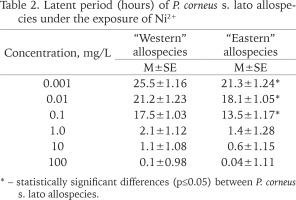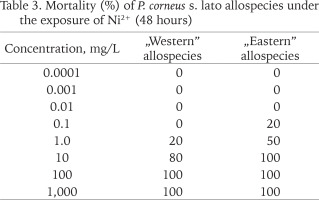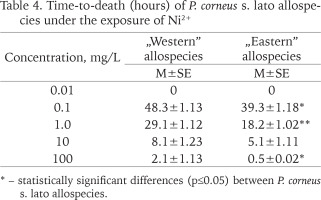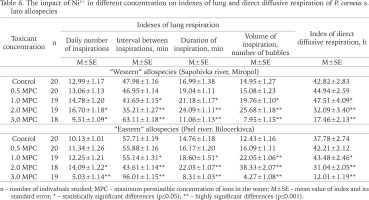INTRODUCTION
The great ramshorn snail Planorbarius corneus (Linnaeus, 1758) was, at the beginning of the 21st century, one of the most widespread and abundant gastropod molluscs in Ukrainian fresh water habitats. It is a widespread species, nominally found from the Atlantic to the Urals and beyond. Recent work, however, based on genetic markers (Garbar 2003, Mezhzherin et al. 2005, Garbar & Garbar 2006) has shown that P. corneus is a superspecies complex, and that in Ukraine there are two vicariant allospecies, western and eastern, significantly differentiated by the centromere indexes of 12th chromosome pair (Harbar et al. 2021). These allospecies are also distinguished by shell size, and by numerous conchological and anatomical variables (Garbar 2003, Babych et al. 2021). The two allospecies are geographically separated by a zone approximately 100 km wide following the Dnipro river channel.
Toxicological studies by Harbar et al. (2021) revealed the impact of different Ni2+ ions concentrations (0.001–1000 mg/L) on the responses of the two allospecies of P. corneus. The indices of mortality, mean lethal time, adaptation coefficients of pulmonary and diffusive respiration appeared significantly different between allospecies (p≤0.05–0.001). In all cases, the eastern allospecies was more sensitive and suffered greater mortality than the western one at any given Ni2+ concentration.
Heavy metal pollution in Ukrainian rivers has increased greatly in recent decades, threatening the functioning of freshwater ecosystems (Babych 2022, Babych et al. 2022). While very low concentrations of some heavy metals are needed for by many freshwater animals, including molluscs (Piwoni-Piórewicz et al. 2017, Santore et al. 2021, Babych et al. 2021, Gandzyura et al. 2021, Uvayeva et al. 2022), increased concentrations become toxic (Brix et al. 2017, Peters et al. 2019, Pinkina et al. 2022).
Ni2+ is among these heavy metals. In very low concentrations it is a necessary component, both in the process of hematopoiesis and of reproduction (Romanenko 2001). At higher concentrations, however, toxic effects become important. These may be complex. While very high concentrations (11.4 mg/L) are lethal to molluscs after 96 hours exposure, the effects are influenced by the age of the molluscs (Haranadha et al. 2011), and by the hydrochemical conditions of environment, level of food consumption, their overall physiological state and genetic features of individuals (Oros & Gomoiu 2010, Zuykov et al. 2013).
The aim of the present study is to compare the ecotoxicological effects of increasing concentrations of Ni2+ ions on the vicariant allospecies of P. corneus.
MATERIAL AND METHODS
The positions of the sampling stations in relation to the biogeography of Ukraine is shown in Fig. 1. A sample (310 specimens) of the western allospecies was made in the Sapohivka river (Prypiat basin) near the Miropol settlement (50°6'27″N, 27°41'45″E, Right Bank Ukraine, Fig. 2), and a sample of 302 of the eastern allospecies from the Psel river near Bilotserkivka village (49°40'17″N, 33°45'39″E) (Fig. 3). Snails were collected by hand from four types of biotopes in each: shallow water of 5–7 cm depth, with bottom covered by Cladophora sp. and with weak, variable flow; sites thickly covered with hemi-immersed water plants (Typha sp., Scirpus sp.) and depth of 15–20 cm, with unnoticeable flow; off the coast at 1–1.25 m depth with powerful development of soft-leaved plants (Myriophyllum sp., Nymphaea sp., Lemna sp.); in the benthic zone, with the bottom covered by plant detritus, and with 0.1–1 m/s flow. Species/allospecies identification was determined on conchological characters, following Garbar (2003), Mezhzherin et al. (2005) and Garbar & Garbar (2006).
Fig. 1
Map showing the typical localities of Planorbarius corneus s. lato allospecies: I – Polissia; II – Forest-Steppe; III – Steppe; IV – Carpathian mountain region; black circle – “western”; black squares – “eastern”
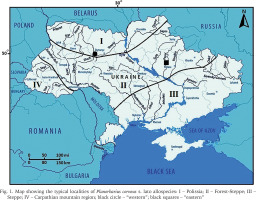
Figs 2–3
Habitats of great ramshorn Planorbarius corneus s. lato: 2 – Sapohivka river (Miropol village, Zhytomyr region); 3 – Psel river (Bilotserkivka village, Poltava region)
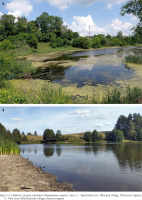
In the laboratory, the snails were subject to a 15-day period of acclimation in aquariums of 30 l volume at a density of 5 snails/L. Water temperature was maintained at 20–23 °C, pH at 7.3–7.8, and oxygenation at 7.6–8.6 O2 mg/L. The water was changed each day, and food, Cladophora sp. and Myriophyllum spicatum L., collected in the sampling sites, was renewed daily.
The first toxicological experiment (Tables 1–5) was conducted by the standard method (Babych et al. 2022, 2023): aquarium volume – 100 L, water temperature – 20–23 °C, pH – 7.3–7.8, oxygenation – 7.6–8.9 O2 mg/L. Toxicant – NiCl2·6 H2O (p.a.) in concentrations between 0.001–100 in mg/L (per cation), expressed also in terms of MPC – maximum permissible concentration. In each of the experimental groups (Tables 1–5) there were 20 specimens of molluscs. Observations were made at 10, 30 min, 1, 2, 4, 6, 24, 48 hours after commencement. Renewing of environments – each day. The impact of toxicant on the molluscs was estimated by the visual observations of changes in their behavior, registering the integrity of the epithelial body covering, its level and functioning, locomotory activity, and intensity of their feeding and digestive processes.
Table 1
The main toxicological characteristics of P. corneus s. lato allospecies under the exposure of Ni2+ (48 hours)
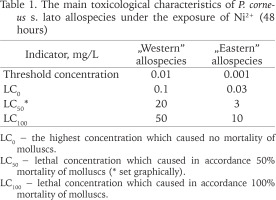
The second toxicological experiment (Table 6) examined the impact of different concentrations of Ni2+ ions on the pulmonary and surface respiration of ramshorn allospecies, following the methods of Babych et al. (2023).
Analysis of results used the standard methods given by Hill & Lewicki (2007) identifying any differences between western and eastern allospecies, using statistically significant differences at the p<0.05 and p<0.001 levels.
RESULTS
The study of the impact of the set of different Ni2+ concentrations on the main toxicological and some physiological indexes of P. corneus sensu lato allospecies established (Tables 1 and 6) that all of them were higher in “western” allospecies that in “eastern” allospecies (p≤0.05–0.001). This confirms the higher level of viability of “western” allospecies: it has a longer latent period (Table 2, p≤0.05), and lethality at the higher doses of toxicants (Table 3) took longer to occur (Table 4, p≤0.05).
It was also established that the range of endurance (mg/L) of “western” allospecies under the impact of sub-threshold, sub-lethal, chronic lethal and acute lethal Ni2+concentrations exceeded those of “eastern” allospecies (Table 5). The data in Table 5 indicates the higher level of sensitivity and lower level of endurance in “eastern” allospecies concerning all used toxicant concentrations.
Table 5
Rating of Ni2+ concentrations (mg/L) according to the effect on P. corneus s. lato allospecies
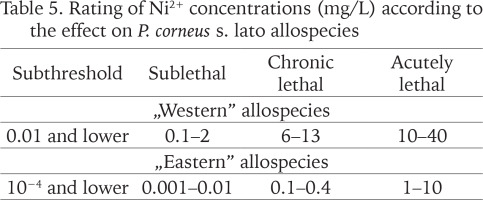
The data in Table 6 proves the more intensive duration of pulmonary as opposed to surface diffusive respiration in the individuals of “western” allospecies comparing to “eastern” allospecies (p≤0.05–0.001).
DISCUSSION
Burning the deposits of fossil energy sources, disposing the wastes of coal and oil refining industry, and the emissions of Ni-Cd batteries production into the hydrosphere components are the main modern sources of Earth freshwater ecosystems pollution by nickel and compounds, and their harmful impact on the hybrobiota (El-Enany & Issa 2000, Binet et al. 2018, Wang et al. 2020). Average yearly emission of Ni2+ into the atmosphere is 55.65 × 103 kg, into the aquatic ecosystems – 113 × 106 kg, and into the soil – 416.5 × 106 kg (Shukla et al. 2009).
Ni2+ ions enter aquatic molluscs mainly from the environment through the body’s ectodermal epithelial coverings, and much less from their plant food (Wong & Pak 2004, Oros & Gomoiu 2010, Yevtushenko & Dudnyk 2019). These ions accumulate first in the hepatopancreas, subsequently distributed among different organs and tissues, maintained by the ongoing circulation of hemolymph.
Ni2+, in very low concentrations, is essential to freshwater gastropods to maintain hematopoiesis at the optimal level (Romanenko 2001), which is one of the crucial conditions for maintenance of their internal homeostasis, and hence their viability and maximum population size and density (Afanasyev & Grodzinsky 2004, Baeva & Chernikh 2020). Exceeding the optimal Ni2+ ion concentrations in the water, however, is progressively more lethal for them (Babych & Pinkina 2021, Harbar et al. 2021). The maximal permitted concentration of Ni2+ for hydrobionts from Ukrainian river network is 0.01 mg/L (Decree of the Cabinet of Ministers of Ukraine 2013). Exceeding this concentration drives a sequence of phasic pathological processes, whose duration is divided into 1 to 5 phases (dependent on the dose acquired), each having a characteristic set of symptoms. Under the MPC of Ni2+ in the environment (0.01 mg/L) the experimental molluscs developed the first intoxication phase – latent, without symptoms, the most secure and the longest. Under 2 MPC, the latent phase changed into the stimulation phase, an increase in physiological activity that maintained viability in experimental conditions. However, the impact of these ions under 3 MPC induced a rapid onset of the three final phases of intoxication – the first and longest being depressive (linked with progressive decrease of all the vital processes), followed by acceleration of these in the sub-lethal phase, and terminating in death.
The “eastern” allospecies moved through these phases more rapidly in relation to ionic concentrations than the “western” allospecies, and its traits developed earlier. The “western” allospecies has evolved more tolerance. The index of direct diffusive respiration in the “western” allospecies is higher than in the “eastern” one when pulmonary respiration is prevented (p≤0.05–0.001); the total amount of oxygen consumed by these molluscs during diffusive surface respiration is almost the same as consumed during pulmonary respiration (Babych 2022). The data in Table 6 also indicates that pulmonary respiration in “western” allospecies is more effective comparing to that in “eastern” allospecies; the “western” allospecies had a greater number of performed “inspirations” (daily) and their duration and volume along with much shorter intervals between them follow the same pattern (p≤0.05–0.001).
It is noteworthy that our results supplement those obtained earlier by Harbar et al. (2021). However we collected material in different period of year. The studied molluscs were studied in different parameters, therefore received different results. This comparison of “western” and “eastern” allospecies of P. corneus sensu lato in terms of their response to increasing concentrations of Ni2+ raises the question of how such differences arose. A possible reason for such a difference may lie in the different nature-geographic conditions in which they have lived (Logvinov & Shcherban 1984, Stadnychenko et al. 2020). These conditions are much harder for “eastern” allospecies, which is distributed in drought climate of the Left-Bank Ukraine and the extreme South of Ukraine’s Steppe Zone.

